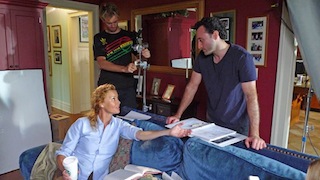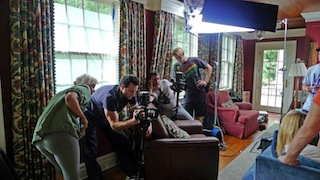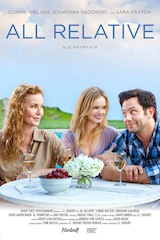 One of the most critical decisions that any independent producer has to make is what camera to choose for a particular project. Such was the case with writer/director J.C. Khoury and director of photography Andreas von Scheele when they filmed their recent feature-length comedy/drama All Relative.
One of the most critical decisions that any independent producer has to make is what camera to choose for a particular project. Such was the case with writer/director J.C. Khoury and director of photography Andreas von Scheele when they filmed their recent feature-length comedy/drama All Relative.
In the end they relied on two Canon EOS C100 cameras and an array of Canon lenses almost entirely within highly accessible locations in New York City and nearby suburban Westchester County.
“Our Canon EOS C100 cameras provided the compact form factor we needed to move quickly,” von Scheele explained. “We shot in attic bedrooms, in cars, in bathrooms, and other tight spaces. The size of the EOS C100 camera let us experiment much more easily because we could play around with different angles. The EOS C100 camera also has a really nice low-light factor. Without huge, hot lights, light stands, and big crews you can create a much smaller, quieter, and less obtrusive space for the actors to focus on their performances. Plus, the EOS C100 camera gave us the ability to shoot in Canon Log for the picture quality we wanted.”
“We definitely had a lot more freedom than if we had shot with a larger camera and crew, and more lights,” Khoury added. “The more you add to the production, the more time and money it takes. The Canon EOS C100 cameras are small, they let us shoot with less light, get closer to walls, and they don’t require as many add-ons, so we could tell the story we wanted to tell without needing to make it a massive producing exercise. It’s always nice to have more money and toys to play with, but sometimes when you have limitations it forces you to find creative solutions instead of just throwing more money at the project. I think a lot of filmmakers are embracing smaller productions because they make it easier to tell the story you want told.”
 The outstanding low-light and cinematic imaging capabilities of the Canon EOS C100 camera are made possible by its advanced Emmy Award winning 16:9 Canon Super 35mm CMOS image sensor and the Canon DIGIC DV III Image Processor. This large 8.3 megapixel CMOS sensor also delivers rich color, low noise, and the depth of field control and dynamic range characteristics digital filmmakers prefer.
The outstanding low-light and cinematic imaging capabilities of the Canon EOS C100 camera are made possible by its advanced Emmy Award winning 16:9 Canon Super 35mm CMOS image sensor and the Canon DIGIC DV III Image Processor. This large 8.3 megapixel CMOS sensor also delivers rich color, low noise, and the depth of field control and dynamic range characteristics digital filmmakers prefer.
“I think we shot the entire film at an ISO of 850,” von Scheele recalled. “There were one or two scenes that went to 1000 ISO, but that was more just to get the right aperture than because we needed more light. What was really nice was to be able to shoot with practicals – lights that are part of your set or location – that you can’t control. When you’re on the street you can just shoot with streetlights or whatever illumination is already there. We shot a lot of stuff on the street at night and that was really convenient.”
“Andreas was able to use streetlights and then add some of our own lights to shape the shot and create the proper ratio,” Khoury added. “But it wasn’t like we had to start from scratch with just our own lights for every shot, although we did do that as well in some situations. The ideal is not to be bound by any restrictions presented by the lights that are already there. You can use them and then shape the shot with your own lights.”
“Many of our choices in adding lights were not done to get a better exposure on our Canon EOS C100 cameras, but because we wanted to manipulate the ratio of the light,” von Scheele elaborated. “For me, one of the best qualities of the EOS C100 camera is its three, built-in ND filters. It’s important to have an aperture that helps sculpt the characters out of the background. That’s why it’s nice to be able to – in any situation – stop-down on the aperture when you can’t control the presence of too much light. We often shot with three of the ND’s – particularly when we were outside – and even in certain daylight indoor scenes we used an ND 1.”
 The Canon EOS C100 Cinema camera features three built-in ND filters (2, 4, and 6 stops, and OFF) that can be deployed using a manual dial. “The ND filters enabled us to basically shoot at a lower f stop and get less depth-of-field so the background would be more out of focus compared to the characters, making them really ‘pop,’ ” said Khoury regarding the bokeh effects he accentuated with those filters.
The Canon EOS C100 Cinema camera features three built-in ND filters (2, 4, and 6 stops, and OFF) that can be deployed using a manual dial. “The ND filters enabled us to basically shoot at a lower f stop and get less depth-of-field so the background would be more out of focus compared to the characters, making them really ‘pop,’ ” said Khoury regarding the bokeh effects he accentuated with those filters.
“Another reason why these ND filters are so great is because they are built into the EOS C100 camera,” von Scheele added. “Instead of having to change external filters in a matte box – which can be time-consuming – you just flick your thumb for the aperture you need.”
In addition to the Canon C100 Cinema camera’s light-control capabilities and overall compactness (its camera body weighs just 2.2 lbs.) Khoury and von Scheele found that the ability to choose among Canon’s wide range of CN-E and EF-series lenses for the EF-mount Canon C100 Cinema camera was also a major creative advantage for shooting All Relative.
“You can theoretically put almost any still photography lens on the Canon EOS C100 Cinema camera and get great picture quality,” von Scheele noted. “In the indie world this can save you a lot of money. We used the Canon CN-E 24mm, CN-E50mm, and CN-E85mm Cinema primes, the Canon EF 14mm f/2.8L II USM ultra-wide-angle, EF 8-15mm f/4L fisheye USM, and EF 100mm f/2.8 macro lenses. The sharpness was very similar, there weren’t noticeable differences, and they all intercut really well.”
“The 24mm and the 50mm made up maybe 90 percent of our shots,” von Scheele continued. “The 50mm was probably the most versatile lens that we had. It has a surprisingly close focus for a Cinema prime. You can get up to 18 inches from an object and still be in focus. You can get a medium two-shot with it and then push in/walk in for a really nice portrait shot.”
 The filmmakers relied on their Canon EF 14mm ultra-wide-angle lens, meanwhile, for shots of the Manhattan skyline and establishing shots of the exterior of their suburban location home. “That 14mm wide-angle lens gives you a really amazing sense of space,” von Scheele confirmed. “Architecture looks really nice when you get more of it in the picture, but shooting a house can be hard because a lot of times you can’t really go back that far before you hit the street or another property. You don’t want to show just half a house in an establishing shot. With the Canon 14mm wide-angle lens, however, you can get something that looks impressive and see more of the full house with less distortion.”
The filmmakers relied on their Canon EF 14mm ultra-wide-angle lens, meanwhile, for shots of the Manhattan skyline and establishing shots of the exterior of their suburban location home. “That 14mm wide-angle lens gives you a really amazing sense of space,” von Scheele confirmed. “Architecture looks really nice when you get more of it in the picture, but shooting a house can be hard because a lot of times you can’t really go back that far before you hit the street or another property. You don’t want to show just half a house in an establishing shot. With the Canon 14mm wide-angle lens, however, you can get something that looks impressive and see more of the full house with less distortion.”
The filmmakers explained that the Canon EF 100mm f/2.8 macro lens was used for a variety of extreme close-ups. “It’s an incredible macro lens,” von Scheele stated. “We used it mostly for pick-up shots of cell phones and things that pushed the story forward, including a golf ball being hit out and pool cues striking pool balls on a table. The Canon EF 100mm macro lens takes very ordinary things and makes them look really beautiful in the way that it handles depth-of-field and allows you to get so close.”
“We also got shots of our characters in bed together in a nighttime attic,” Khoury added. “We used two Canon EOS C100 Cinema cameras at the same time. I was on the 50mm and Andreas was on the 100mm macro getting very close, detailed stuff.”
“We could really isolate – and get great detailed shots of – their eyes with the 100mm macro because you can get in so close, von Scheele agreed.”
The Canon EOS C100 Cinema camera features an industry-standard workflow-compatible AVCHD codec, recording 1920 x 1080 HD using MPEG-4 AVC/H.264 compression at data rates of up to 24-Mbps to two SD cards. The filmmakers recorded their footage both to the cards and to an Atomos Ninja 2 HDMI recorder.
“When you’re shooting Canon Log, you really want to get that dynamic range, and the Ninja gives you a little bit more latitude than the cards,” Khoury noted. “The EOS C100 camera makes great images and Canon Log gave us a lot more space and dynamic range to play with. Our images held up quite well in post. At the end of the day audiences don’t walk out of a movie theater saying, ‘I loved the lighting in that third scene.’ What most people really focus on is the story and the performances. The camera and all of the technical stuff is there to support that.”
“All of our Canon equipment worked great,” Khoury added. “These days, you don’t need millions and millions of dollars to make a high-quality movie that people will want to see. The EOS C100 is a great camera when you’re working on a lower budget. Our Canon EOS C100 Digital Cinema cameras really delivered for us.”
